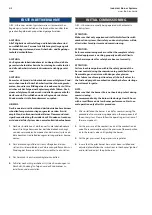
Industrial Burner Systems
5/8
www.ibs-brenner.de
ZünDunG
1. Es ist sicherzustellen, daß der Zündbrenner dicht in den dafür
vorgesehenen Anschluss am Brenner eingebaut ist.
2. Das Zündkabel des Transformators mit dem Zündstecker auf
die Zündkerze des Zündbrenners stecken.
3. Überprüfen ob der Zündstecker richtig auf der Mitte der
Zündkerze steckt.
HInweIS:
eine einwandfreie erdung des Zündbrenners ist herzustellen
um Schäden an ausrüstung oder Personen zu vermeiden. Die
Verwendung kurzer Zündkabel wird empfohlen (ca. 1,5 m)
um die sichere und reproduzierbare Zündung zu erreichen.
Der Zündtransformator erzeugt eine Zündspannung von
5000 Volt. Die Zündung führt zum auftreten einer offenen
Flamme. während des gesamten Zündvorgangs ist zum
Zündkabel, zum Zündstecker und zu der Düse des Zünd-
brenners ein sicherer abstand zu halten.
4. Sicherstellen, dass der Gasabsperrhahn geschlossen ist.
5. Ventilator oder Luftzufuhr starten.
6. Luftvolumenstrom zum Zündbrenner bis zum Maximum
freigeben.
7. Zündtransformator starten und überprüfen ob ein aus-
reichender Zündfunke im Zündbrenner auftritt.
8. Gasabsperrhahn vollständig öffnen. Während der gesamt
Dauer des Betriebs des Zündbrenners muß der Gasabsperr-
hahn voll geöffnet bleiben.
9. Zündbrenner so lange einstellen, bis sich eine scharfe blaue
Flamme mit hoher Geschwindigkeit bildet. Wird der Zünd-
brenner außerhalb des Hauptbrenners eingestellt, ist die
Einstellung eines Luftüberschusses empfohlen, um nach dem
Einbau in den Hauptbrenner eine korrekte Flamme zu errei-
chen. Die Einstellung des Gas-Luft-Verhältnisses erfolgt in drei
Schritten:
Kontermutter am Mischer lösen
wird die Einstellschraube am Mischer im Uhrzeigersinn
gedreht bewirkt dies eine Erhöhung der Luftmenge; wird
die Einstellschraube am Mischer gegen den Uhrzeigersinn
gedreht, bewirkt dies eine Verringerung der Luftmenge
Kontermutter am Mischer festziehen
10. Um den Zündbrenner abzustellen zuerst den Gashahn
schließen.
IGnItIOn
1. Check, if the pilot burner is threaded tightly into the pilot
port at the burner.
2. Connect the ignition wire of the transformer with the spark
plug cab to the spark plug of the pilot burner.
3. Check, if the spark plug cab is connected correctly to the
center of the spark plug.
nOte:
Provide a faultless grounding of the pilot burner in order to
avoid damages of the equipment or persons. we recommend
to use short ignition cables (approx. 1,5 m) to ensure a safe
and repeatable ignition.
the ignition transformer generates an ignition voltage of
5.000 Volt. the ignition produces an open flame. Please keep
a safe distance to the ignition wire, to the spark plug cab and
to the nozzle of the pilot burner during the whole ignition
process.
4. Make sure that the gas shut-off valve is closed.
5. Start the fan or air supply.
6. Open the air volume flow to the pilot burner to the maximum.
7. Start pilot burner and check if a sufficient ignition spark is
generated in the pilot burner.
8. Open the gas shut-off valve completely. The gas shut-off
valve has to stay completely opened during the whole opera-
tion of the pilot burner.
9. Adjust the pilot burner until a sharp blue flame with high
velocity is produced. In case that the pilot burner has to be
adjusted from outside of the main burner, we recommend to
adjust an air surplus in order to generate a correct flame after
the pilot burner has been mounted into the main burner. The
adjustment of the gas-air-ratio has to be made in three steps:
Untighten the lock nut at the mixer
Turning the setting screw at the mixer in clockwise direction
will increase the quantity of air. Turning the setting screw at the
mixer in counterclockwise direction will reduce the quantity of air.
Tighten the lock nut at the mixer.
10. To stop the pilot burner, first close the gas shut-off valve.


























